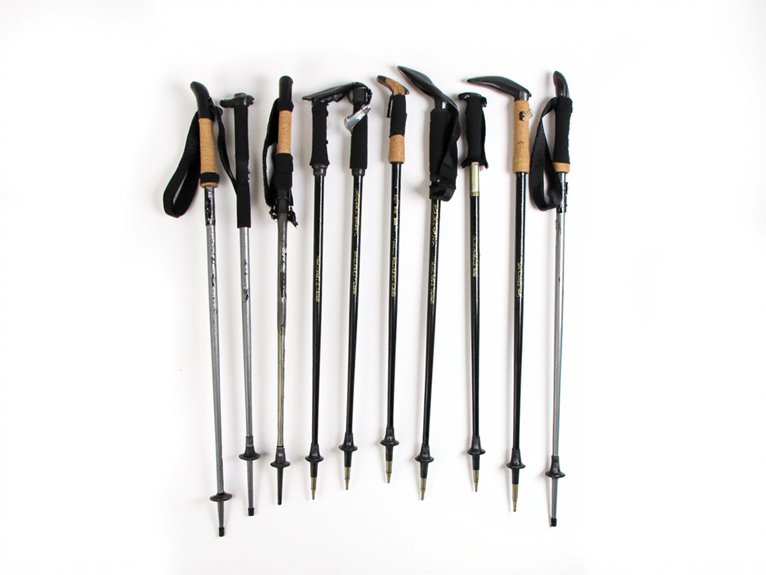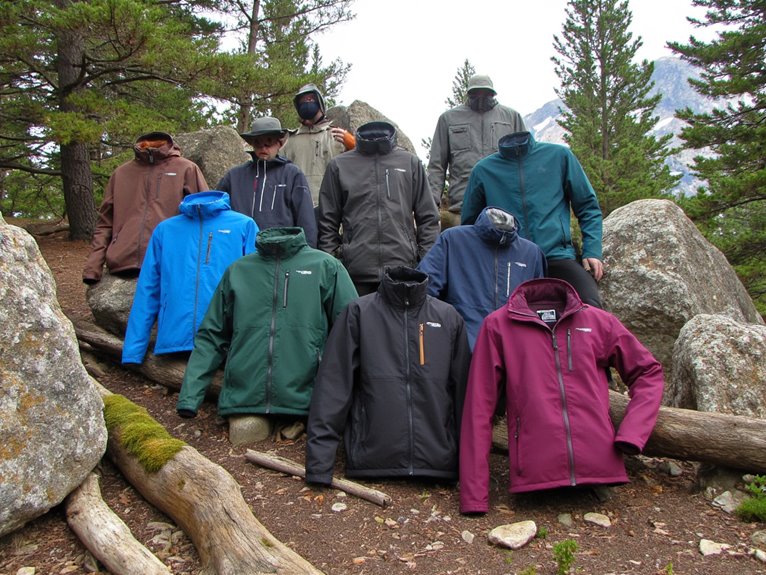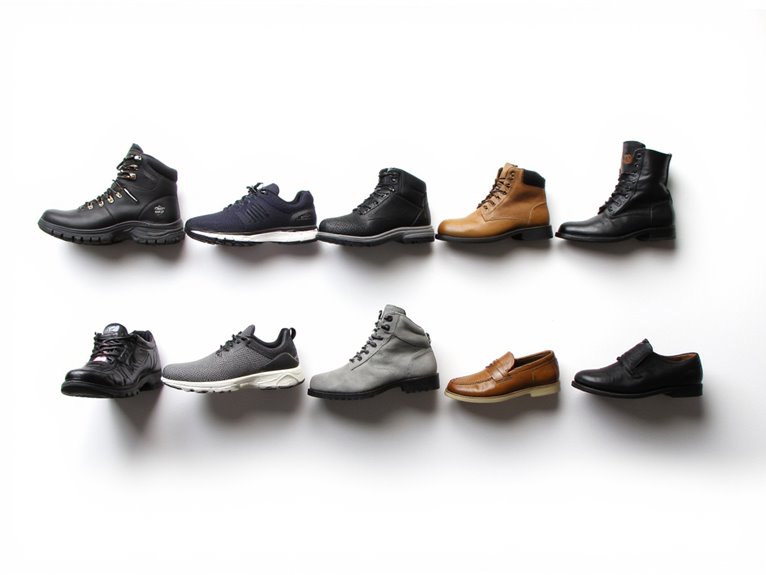Storing Gear Between Seasons: Preventing Mold and Damage
Prevent gear damage by cleaning everything thoroughly before storage, removing dirt, sweat, and food residues that attract mold and pests. Store items in cool, dry locations maintaining 50-80°F temperatures and 30-50% humidity using dehumidifiers and moisture absorbers. Choose airtight containers or breathable garment bags based on material type, avoiding compression for insulated items. Hang heavy fabrics while folding lightweight ones, ensuring complete dryness before storage. Monthly inspections catch problems early, while proper preparation extends equipment lifespan considerably.
We are supported by our audience. When you purchase through links on our site, we may earn an affiliate commission, at no extra cost for you. Learn more. Last update on 7th January 2026 / Images from Amazon Product Advertising API.
Notable Insights
- Clean all gear thoroughly and ensure complete drying before storage to prevent mold growth and material degradation.
- Maintain storage humidity between 30-50% using dehumidifiers and include silica gel packets in containers for moisture control.
- Store items in cool, dry locations with temperatures between 50-80°F, avoiding attics and basements prone to temperature fluctuations.
- Use airtight containers with proper ventilation spacing and conduct monthly inspections to monitor for pest activity and damage.
- Avoid compressing insulated gear long-term and hang heavy items on padded hangers to preserve shape and functionality.
Essential Cleaning Steps Before Storage
Although many outdoor enthusiasts enthusiastically pack away their gear after an adventure, skipping proper cleaning steps can lead to expensive equipment replacement down the road. You must remove all dirt, mud, and debris immediately after use to prevent material degradation.
Proper cleaning techniques vary by equipment type. Use technical fabric detergents for waterproof shells and insulated layers. Clean boot interiors thoroughly to eliminate sweat that causes mold and odors.
Technical fabric detergents preserve waterproof gear performance while thorough boot cleaning prevents moisture-related mold and unpleasant odors from developing.
Scrub cookware with soap and water, removing all food residues that attract bacteria. Empty backpack pockets completely and wipe surfaces with damp cloths.
Pay special attention to hiking shoes with Vibram outsoles, as dirt trapped in aggressive lug patterns can harbor bacteria and compromise traction performance over time.
Ascertain everything dries completely before applying appropriate storage materials like breathable garment bags and moisture absorbers to prevent mildew development.
Selecting the Right Storage Containers
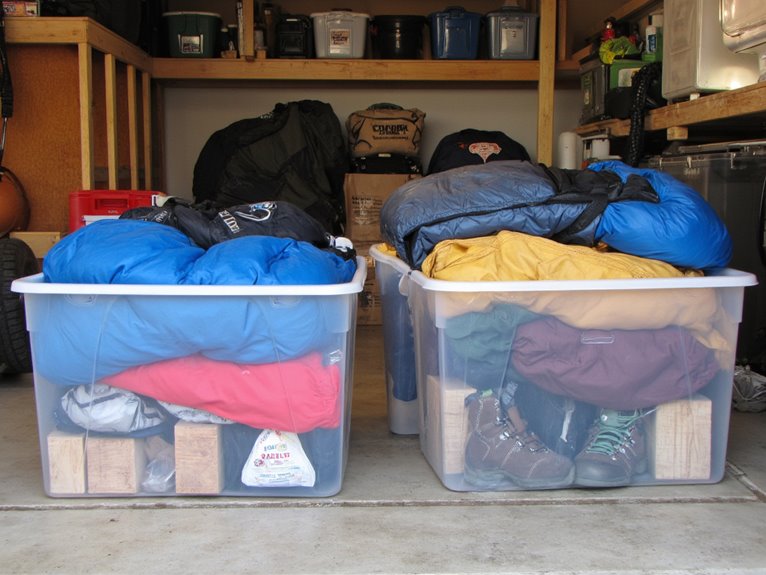
Anyone can toss gear into whatever container they find lying around, but smart storage requires deliberate container selection based on specific technical requirements. Your container features must prioritize weatherproofing, durability, and appropriate sizing. Hard plastic containers excel in robustness, while soft-sided options offer collapsibility for space-constrained storage areas.
| Container Type | Capacity | Material | Weatherproof | Portability |
|---|---|---|---|---|
| Hard Plastic Bins | 50-100L | Polypropylene | Excellent | Moderate |
| Soft-Sided Bags | 30-80L | Cordura/Nylon | Good | High |
| Collapsible Containers | 40-75L | Hybrid Materials | Variable | Excellent |
| Modular Systems | 25-60L | Reinforced Plastic | Excellent | Good |
| Specialty Cases | 15-45L | Custom Materials | Superior | Moderate |
Storage materials directly impact longevity and protection levels. Polypropylene provides maximum durability, while reinforced corners prevent structural failure during transport and stacking.
Managing Humidity and Air Circulation
Moisture control determines whether your carefully stored gear emerges pristine or permanently damaged when the next season arrives. Maintain indoor humidity between 30% and 50% using dehumidifiers in basements and enclosed storage rooms. Monitor levels with a hygrometer and adjust accordingly. Place silica gel or activated charcoal packets inside containers to absorb excess moisture.
Air circulation prevents stagnant conditions that trap moisture and promote mold growth. Leave space between stored items and walls to guarantee airflow around containers. Use storage areas with windows, vents, or install small fans for continuous air movement.
Avoid tightly sealed containers for textiles unless moisture absorbers are included. Routinely air out storage spaces to reduce dampness and refresh fabrics, preventing costly gear replacement. For emergency blankets and Mylar materials, ensure careful handling during storage since these materials can tear easily when exposed to improper conditions.
Effective Pest Prevention Strategies
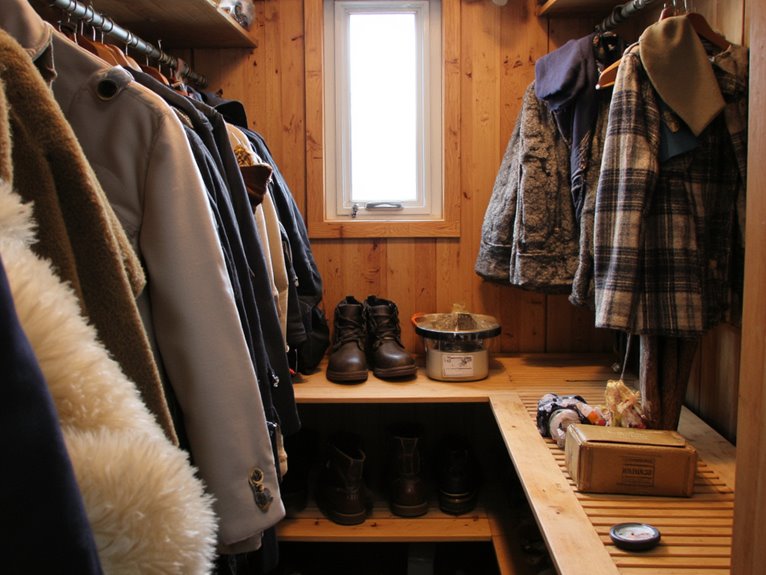
While moisture control protects your gear from environmental damage, pests pose an equally serious threat that can destroy even properly dried equipment within a single storage season. Moths, beetles, and rodents can penetrate cardboard boxes and fabric bags within weeks.
Use airtight plastic containers with secure lids as your primary defense. Vacuum-sealed bags eliminate air pockets where insects hide while preventing entry points.
Clean all items thoroughly before storage-food particles, sweat, and oils attract textile pests like carpet beetles.
Deploy natural repellents including cedar blocks, lavender sachets, and bay leaves inside containers. These pest deterrents require replacement every six months as effectiveness diminishes.
Store items off the ground on shelving to block rodent access. Conduct monthly inspections for droppings, holes, or shed insect skins.
Protect valuable camping gear like collapsible cutting boards and multi-tools by wrapping them individually in moisture-absorbing materials before placing in sealed containers.
Proper Care for Fabrics and Outerwear
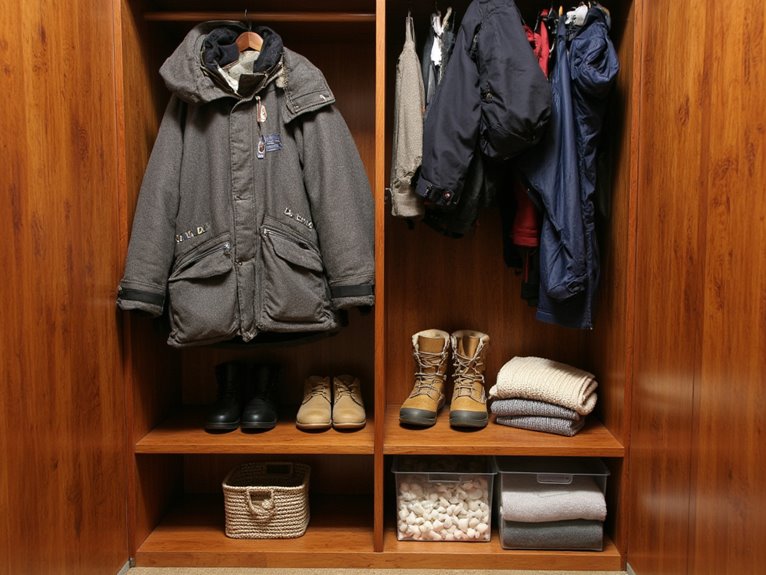
Your fabric and outerwear storage method directly impacts their longevity and performance when you retrieve them next season.
The choice between hanging and folding depends on the garment’s weight, fabric composition, and insulation type, while proper container selection guarantees breathability without compromising protection from moisture and pests.
Understanding compression limits and shape preservation techniques will prevent permanent damage to technical fabrics and maintain the structural integrity of your gear.
For down-filled coats, avoid excessive compression during storage as this can damage the insulation’s loft and reduce its thermal efficiency when you need it most.
Hanging Vs Folding Methods
Before you decide between hanging and folding your seasonal gear, consider the fabric type and weight as your primary determining factors.
Heavy fabrics like wool coats and leather jackets require hanging techniques to maintain structural integrity and prevent permanent creasing. Use padded hangers for delicate materials such as silk to avoid fabric distortion.
Folding strategies work best for lightweight, stretchable fabrics including cotton T-shirts and synthetic activewear, preventing hanger-induced stretching. Heavy sweaters need folding to avoid gravity-related elongation.
Hanging promotes superior air circulation around fabrics, reducing moisture buildup that causes mold growth in humid storage conditions. This airflow advantage becomes critical for wet outdoor gear like rain jackets and sleeping bags, where trapped moisture creates ideal mold conditions.
Similarly, waterproof hiking boots benefit from hanging storage methods to maintain their seam-sealed construction and prevent moisture accumulation that could compromise their protective barriers.
Breathable Storage Solutions
Why does proper air circulation matter so much for stored seasonal gear? Trapped moisture creates the perfect environment for mold and mildew growth.
You’ll want to choose breathable fabrics like cotton, canvas, or mesh bags instead of plastic containers. These materials allow continuous airflow while protecting your gear.
Natural cotton bags provide excellent moisture management for sleeping bags and jackets. Mesh storage sacks work perfectly for boots and gloves, offering both ventilation and visibility.
Quality ripstop nylon with ventilation panels balances durability with airflow needs.
Always guarantee your gear is completely dry before storage. Don’t pack items tightly-leave space for air circulation.
Add silica gel packets inside breathable storage containers for extra moisture control. Store everything in cool, dry areas away from direct sunlight.
When storing softshell jackets, their breathable membrane construction helps prevent moisture buildup even during long-term storage.
Compression and Shape Preservation
While proper drying and breathable storage prevent moisture damage, compression techniques and folding techniques determine whether your gear maintains its performance characteristics season after season.
Avoid long-term compression storage for insulated garments. Down and synthetic fill lose loft when compressed, reducing thermal efficiency by up to 40%. Instead, use these shape retention methods:
- Fold garments loosely rather than stuffing them into tight spaces to preserve fabric integrity.
- Hang waterproof outerwear on padded hangers to prevent membrane damage and shoulder deformation.
- Store sleeping bags uncompressed to maintain insulation properties and extend lifespan.
- Use boot trees or newspaper to prevent footwear collapse and maintain structural shape.
Sharp creases damage waterproof membranes permanently. Choose even, gentle folds that distribute stress across fabric surfaces rather than concentrated pressure points.
Proper storage also applies to camping lights, which benefit from removing batteries during off-season storage to prevent corrosion and maintain their battery life for future adventures.
Regular Monitoring and Maintenance
Your gear won’t maintain itself while stored away, so you’ll need to establish a systematic monitoring routine that prevents small problems from becoming expensive replacements.
Set up a seasonal inspection schedule every 1-3 months, rotate your stored items to prevent prolonged storage damage, and refresh protection materials like moisture absorbers and pest deterrents on a regular basis.
This proactive approach catches issues like mold growth, fabric deterioration, and pest activity before they compromise your investment in quality outdoor equipment.
Seasonal Inspection Schedule
Three critical checkpoints throughout the year form the backbone of an effective seasonal inspection schedule: pre-storage preparation in late fall, mid-season monitoring during winter months, and pre-use evaluation before spring deployment.
Proper inspection frequency depends on gear type and storage duration, with specialized equipment requiring monthly checks while standard items need quarterly reviews.
Your seasonal priorities should focus on environmental shifts when temperature and humidity fluctuations create ideal mold conditions:
- October-November: Complete deep cleaning and initial storage setup with baseline documentation
- January-February: Mid-winter assessment focusing on humidity control and condensation detection
- March-April: Pre-deployment inspection with functionality testing and damage evaluation
- Ongoing monitoring: Weekly environmental readings using digital hygrometers maintaining relative humidity below 60%
Document all findings systematically for historical comparison and trend analysis. When storing ultralight backpacks, ensure proper ventilation and avoid compressing them wet, as their tear-resistant nylon construction can trap moisture and develop mold in confined spaces.
Rotating Stored Items
How often should you physically move and inspect your stored gear to prevent deterioration? Your rotation frequency should align with seasonal patterns, typically every 3-4 months for most equipment. This schedule prevents material compression and exposes items to fresh air circulation.
Create systematic gear accessibility by grouping items according to usage patterns. Store frequently rotated gear in easily reachable locations using modular shelving or stacking bins. Label each container with rotation dates to track movement cycles effectively.
During each rotation, conduct thorough visual inspections for mold, rust, or pest damage. Test mechanical components for stiffness or corrosion. Replace moisture absorbers and air out enclosed containers briefly.
Clean items even without visible contamination to prevent buildup. Document all maintenance activities to monitor long-term gear health and establish reliable maintenance schedules. Electronic devices like GPS units require special attention during rotation, as their batteries should be charged periodically and software updated to maintain optimal performance.
Refreshing Protection Materials
While seasonal rotation maintains your gear’s structural integrity, the protective treatments and materials themselves require dedicated maintenance to preserve their functional performance.
Water repellent treatments degrade through UV exposure, washing cycles, and general wear. Without proper renewal, fabrics lose waterproofing capabilities and become vulnerable to moisture infiltration.
Follow this systematic approach for renewing protection materials:
- Clean thoroughly before applying any treatments to guarantee effective bonding
- Use wash-in repellents like Revivex for machine-washable items after thorough cleaning
- Apply spray-on treatments for gear unsuitable for machine drying processes
- Choose PFC-free products such as Nikwax to minimize environmental impact while maintaining performance
Clean gear before treatment application guarantees maximum effectiveness.
This maintenance cycle restores barrier integrity and extends equipment lifespan considerably.
Temperature Control and Location Selection
When selecting storage for seasonal gear, temperature control becomes the critical factor that determines whether your equipment survives months of dormancy or suffers irreversible damage.
Temperature stability prevents warping, cracking, and corrosion that destroys valuable equipment. Maintain temperatures between 50°F and 80°F to minimize condensation and heat damage.
Location factors directly impact storage success. Choose cool, dry spaces away from attics, basements, and non-insulated garages.
These areas experience temperature swings that promote moisture condensation. Climate-controlled units provide HVAC systems that regulate both temperature and humidity year-round.
Install thermometers or hygrometers to monitor conditions. Use elevated shelving to prevent floor contact.
Supplement climate control with moisture absorbers and desiccant packs. Select facilities near your home for convenient seasonal rotation while ensuring proper ventilation throughout the storage space.
Emergency Response for Storage Issues
Despite careful temperature management and location selection, storage emergencies can strike without warning and demand immediate action to save your valuable gear. Effective emergency protocols require rapid assessment of the situation and systematic intervention to minimize damage.
When storage issues occur, follow these critical steps:
- Monitor environmental conditions using humidity sensors to detect moisture spikes above 50% relative humidity.
- Isolate contaminated items immediately to prevent mold spread throughout your storage area.
- Increase ventilation with fans or dehumidifiers to halt further moisture accumulation.
- Document damage patterns to identify recurring problems and improve future storage practices.
Deploy moisture absorbers like silica gel packets for immediate humidity control. Clean affected surfaces with diluted bleach solutions appropriate for each material type.
For gear that requires immediate cleaning, biodegradable wipes can effectively remove moisture and contaminants without leaving harmful residues that could further damage stored equipment.
Maintain detailed records of incidents to establish prevention strategies.
Frequently Asked Questions
How Long Can Gear Safely Remain in Storage Without Inspection?
You shouldn’t leave gear in storage without inspection for more than three to four months. Your gear’s lifespan depends heavily on proper inspection frequency during extended storage periods.
Materials can degrade considerably after six months without checking, especially in fluctuating temperatures. Down insulation loses effectiveness when compressed long-term, while fabrics develop mold and pest damage.
Monthly checks during active storage seasons prevent costly replacements.
Should I Store Summer and Winter Gear Together or Separately?
You should store summer and winter gear separately.
Separating gear reduces clutter, prevents dirt transfer between items, and improves accessibility during seasonal swaps.
Seasonal considerations include your regional climate-temperate zones allow some cross-seasonal storage flexibility.
Group similar items together: winter coats with mittens, summer shorts with swimsuits.
This organization method maximizes space efficiency, enables focused maintenance, and protects garments from contamination damage.
What’s the Ideal Room Temperature Range for Storing Outdoor Gear?
You’ll want to maintain your storage space between 50°F and 70°F for ideal gear preservation.
This temperature range prevents material degradation while avoiding condensation issues. Choose an ideal storage location like a climate-controlled indoor room rather than unheated garages or basements.
Maintain ideal humidity levels below 60% with proper ventilation.
Temperatures exceeding 90°F accelerate rubber seal breakdown and synthetic material deterioration in your equipment.
Can I Use Dryer Sheets Instead of Cedar Blocks for Repelling Moths?
You shouldn’t rely on dryer sheets as moth repellent alternatives.
Dryer sheet effectiveness against moths is unsupported by scientific evidence-they lack the bioactive compounds needed to deter larvae.
Cedar blocks release natural oils that make keratin fibers less palatable to moth larvae, though their scent fades over time.
Dryer sheets only mask odors temporarily with synthetic fragrances, providing no actual protection against wool-eating pests.
Is It Safe to Store Wet Weather Gear in the Same Area as Electronics?
You shouldn’t store wet weather gear near electronics due to serious wet gear safety risks.
Moisture from damp gear increases humidity levels, causing electronics damage through corrosion and component failure.
Even seemingly dry gear retains residual moisture that creates harmful conditions.
Store wet gear separately until completely dry, then use climate-controlled units with proper segregation to protect sensitive electronic equipment.
On a final note
You’ve established a thorough storage system that’ll protect your gear for years. Monitor stored items quarterly during the first year, then semi-annually thereafter. Temperature fluctuations exceeding 15°F within 24 hours can damage materials, so relocate items if necessary. If you discover moisture, mold, or pest activity, don’t panic-address issues immediately using the emergency protocols outlined above. Proper storage isn’t just preservation; it’s an investment in your equipment’s longevity and performance.

